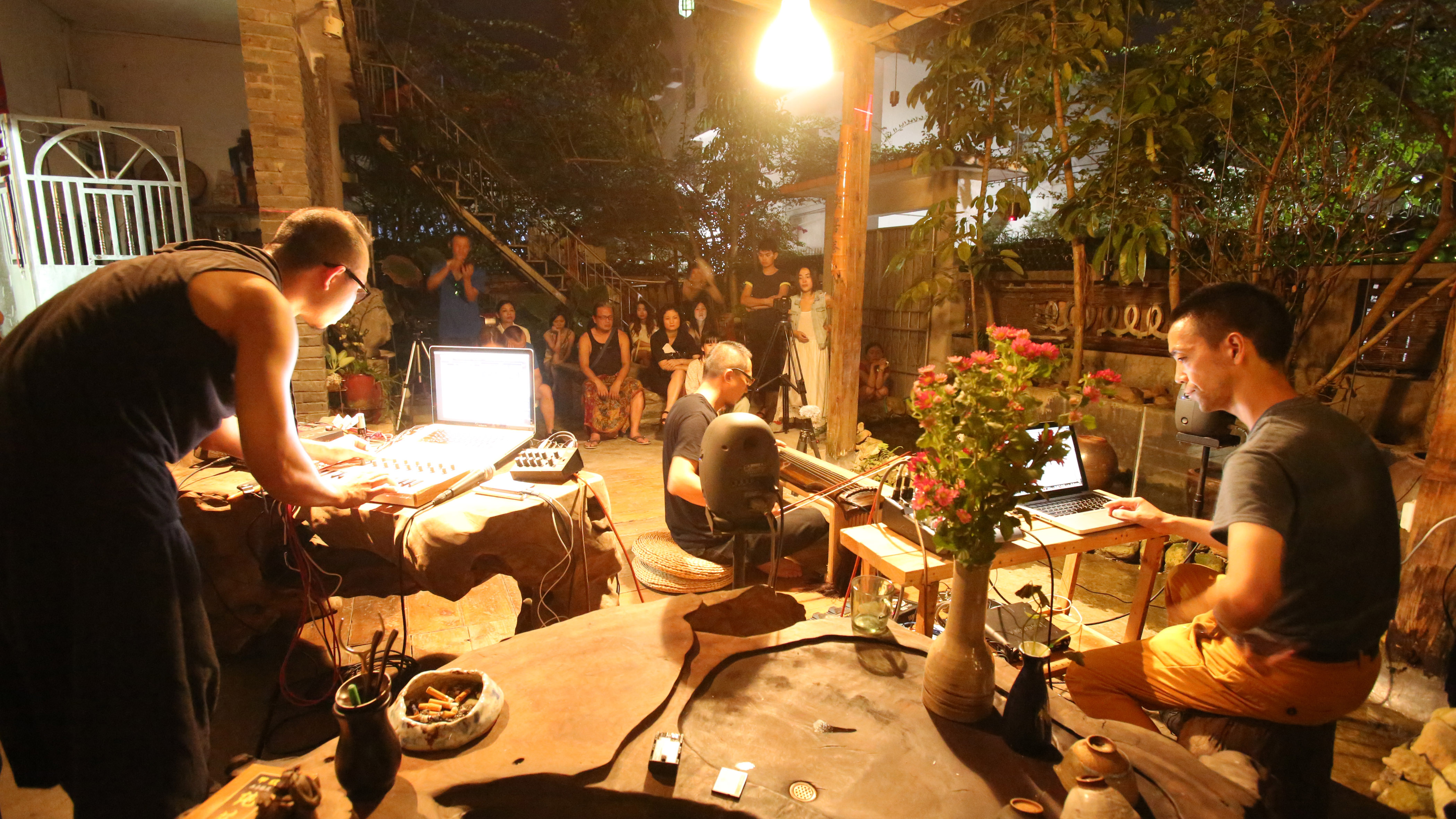 |
|
Shen Piji and his friends improvising with frogs’ croaking in the courtyard of his studio with the guqin, the bow of the morin khuur, and electronic synthesizers. |
 |
|
Shen Piji and his friends improvising with frogs’ croaking in the courtyard of his studio with the guqin, the bow of the morin khuur, and electronic synthesizers. |
Born in 1971 in Zhao'an, Minnan Province, Shen Piji studied modern lacquer painting at the Xiamen Academy of Arts and Design, Fuzhou University in 1988 and began his sound experiments and visual arts practices in the early 1990s. He has lived and worked in Shenzhen since 1993, where he made a living as a designer while being a guitarist and vocalist in a punk band. In 2008, he began to study after Li Jia'an, a master of Guangling School of Qin, and has been practicing the guqin for more than 10 years since then. While preserving and revolving his thinking around the spirit of the guqin, Shen Piji also attempts to translate his understanding of Chinese traditions into contemporary expressions. His works involve performance, installation, painting, sound, music, video, and new media, among others – for a self-proclaimed old punk, these experiments came naturally to him. Also, having studied traditional Chines culture since young, the artist has always see classical art as a solid foundation and source of inspiration for his practices.
The structure and playing methods of the guqin invoke the orders of nature, including the relationships among heaven, earth, and humans. The guqin uses sān fēn sǔnyì lǜ (literally translated as the “Law of Three-scale Fall and Rise Temperament”) to calculate music rhythms and natural harmonics for tunings. Scores of the guqin only establish the flow of music rhythms within a certain range and do not specify the rhythms. The guqin thus prefers ragged rhythms and allows for plenty of space for improvisations, which means infinite variations and fun for Shen Piji, who sees the guqin as suitable for developing purely experimental music and even has associated the instrument with the vocalization of the guitar.
 |
|
The guqin sheet music collected by Shen Piji documented playing techniques that imitate the movements in nature. When playing the guqin, the techniques are as important as the pitch and rhythm – they suggest the sense of temporality and spatiality between notes and together shape the melodic line. |
Shen Piji’s studio is located in Hengpailing Village, southeast of Shenzhen, backed by Wutong Mountain National Park (22°23'-22°43'N, 113°17'-114°18'E; total area: 31.82 square kilometers). One day in 2010, Shen Piji came to visit a friend in Hengpailing Village and were immediately attracted to the environment there. Since then, they have been living in the village: “We wake up every morning to birdsongs that come from different directions and thus produce a surround sound effect. The sounds also flow as the birds fly.” Shen’s studio has three floors. Looking out from the top floor, one can see three overlapping mountain peaks in dark green.
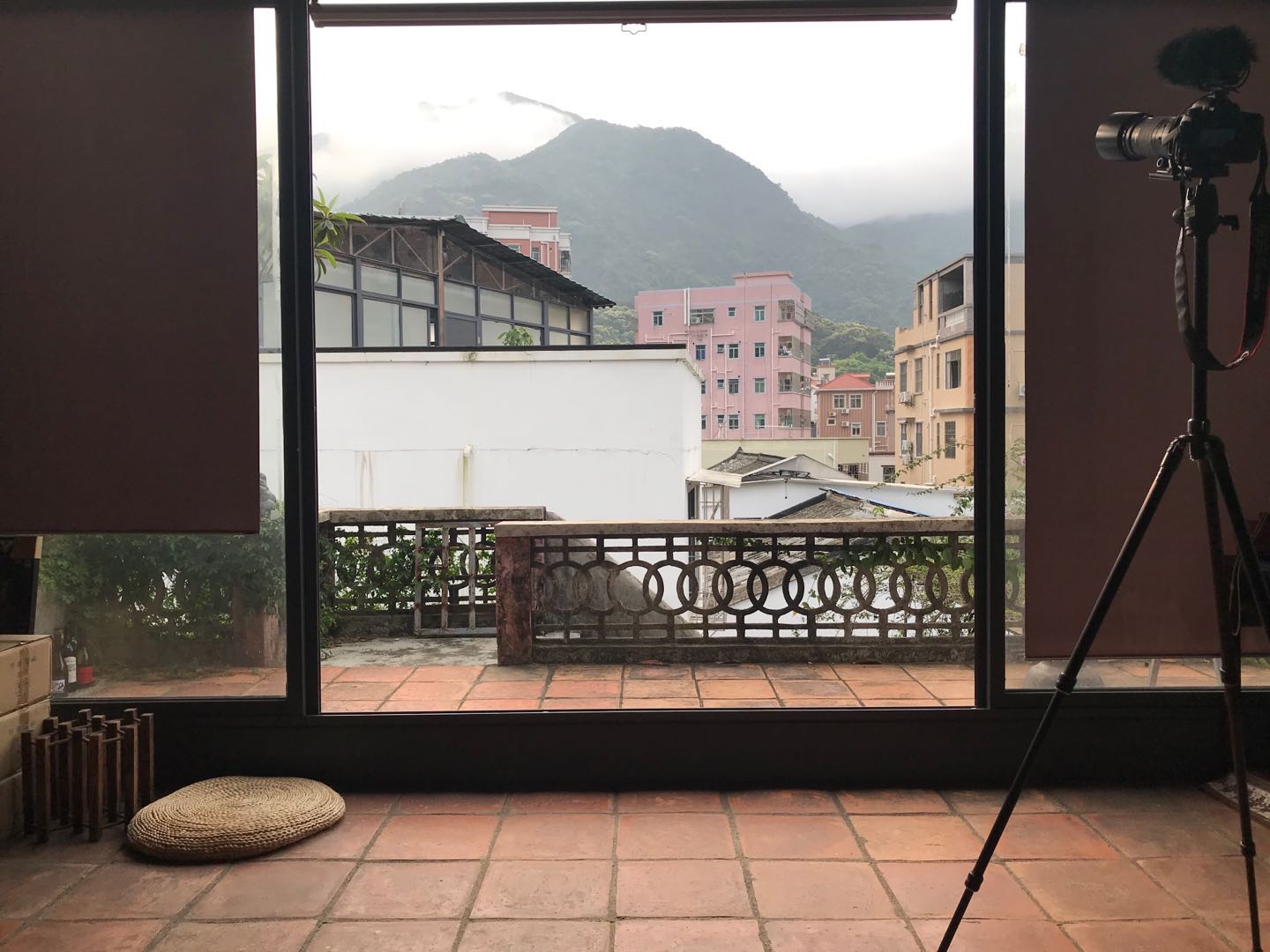 |
|
The view from the third floor of the studio |
Shen Piji and his friend Stephen Emery once improvised the series “Wutong Mountain” that consists of nine pieces, which they created with the guqin and bass against the vast mountainous scenery. In making this series, they initiated a dialogue with the various scenes and sounds in the mountain.
Tao Hua Yuen
Sound | 6'09" | Hengpailing, Shenzhen | 2018
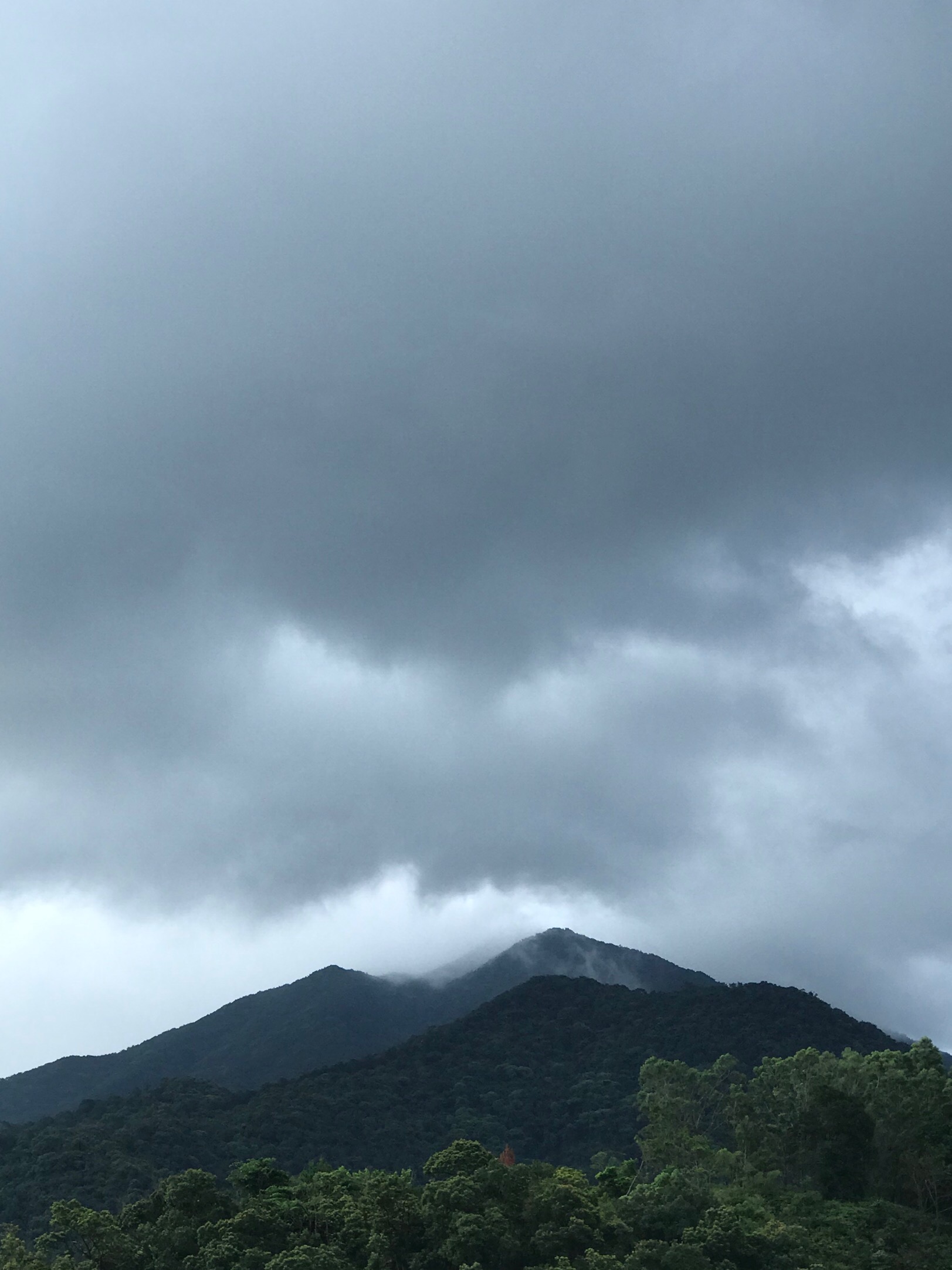 |
|
Wutong Mountain |
"Sound Experiment with Hylarana daunchina" is based on Shen Piji’s everyday life experience. Soon after moving to Wutong Mountain, the artist started to often hear the croaking of all kinds of frogs, many of which frequently visited them. After a while, some even settled in their courtyard. One species among the frogs has a rich, variable, and pleasant sounds. With a dark brown color, the frog has a flat head and slick skins on the back covered with black stripes. It shows no fear of humans and would even sing along when people play the qin, blowing the vocal sacs on both sides of its throat into small drums. He asked his friends about the frog and learned its name – Hylarana daunchina. He also discovered a legend about the frog when looking up the materials: it is said that Li Bai, the poet in the Tang Dynasty who is also known as the Immortal of Poetry, once sojourned at Wannian Temple for months. When he listened to Zen Master Guang Jun playing the qin beside Baishui Pond, he often saw a young girl dressed in cyan also listening aside. The girl was the incarnation of Hylarana daunchina. For the frog often listening to Zen Master Guang Jun’s music, its croaking became sounding like the qin. Such a legend naturally excited musicians like Shen Piji, who has developed a stronger interest in the Hylarana daunchina. After a period of observation and research, the artist arranged five clay water tanks of varied sizes in a shallow pond in his courtyard to attract more frogs to settle there.
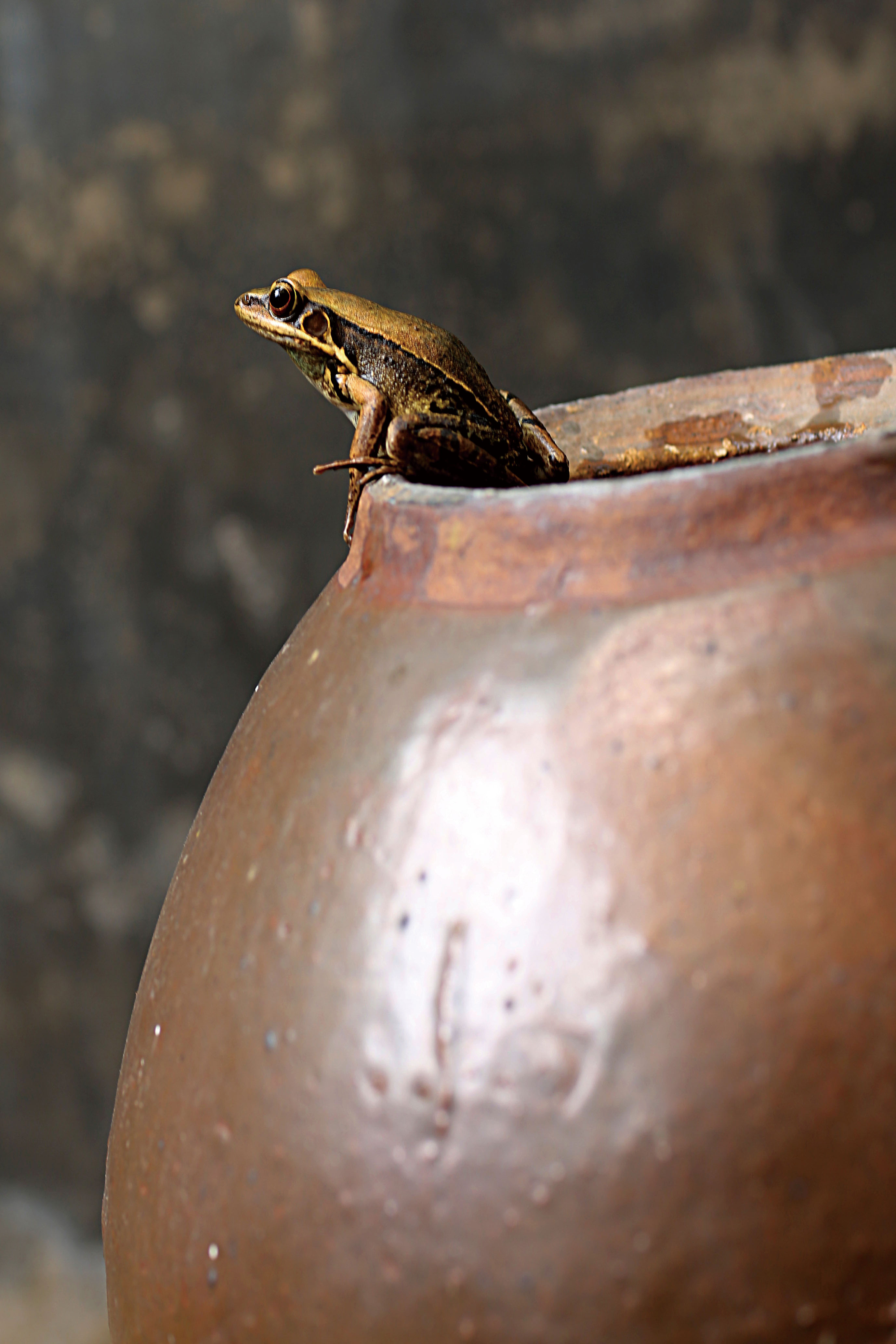 |
|
Hylarana daunchina living in the courtyard of Shen Piji’s studio |
As his longtime companionship with frogs develops, Shen Piji has summed up some patterns of how frogs’ croaking changes with time, seasons, and weather. For example, thunders particularly liven the frogs up; on the day of the solar term Gǔyǔ (literally translated as “Grain Rain”), frogs will also make extremely loud croaking. Yet, once after Lìqiū (literally translated as “Beginning of Autumn”), the frogs would become silent. Also, Hylarana daunchina seems to prefer the sounds of the guqin with silk strings to the synthesized sounds of electronic instruments. To better document the everyday status of this species, Shen Piji often holds his camera in the courtyard but dares not to get too close to the frogs in case they are startled.
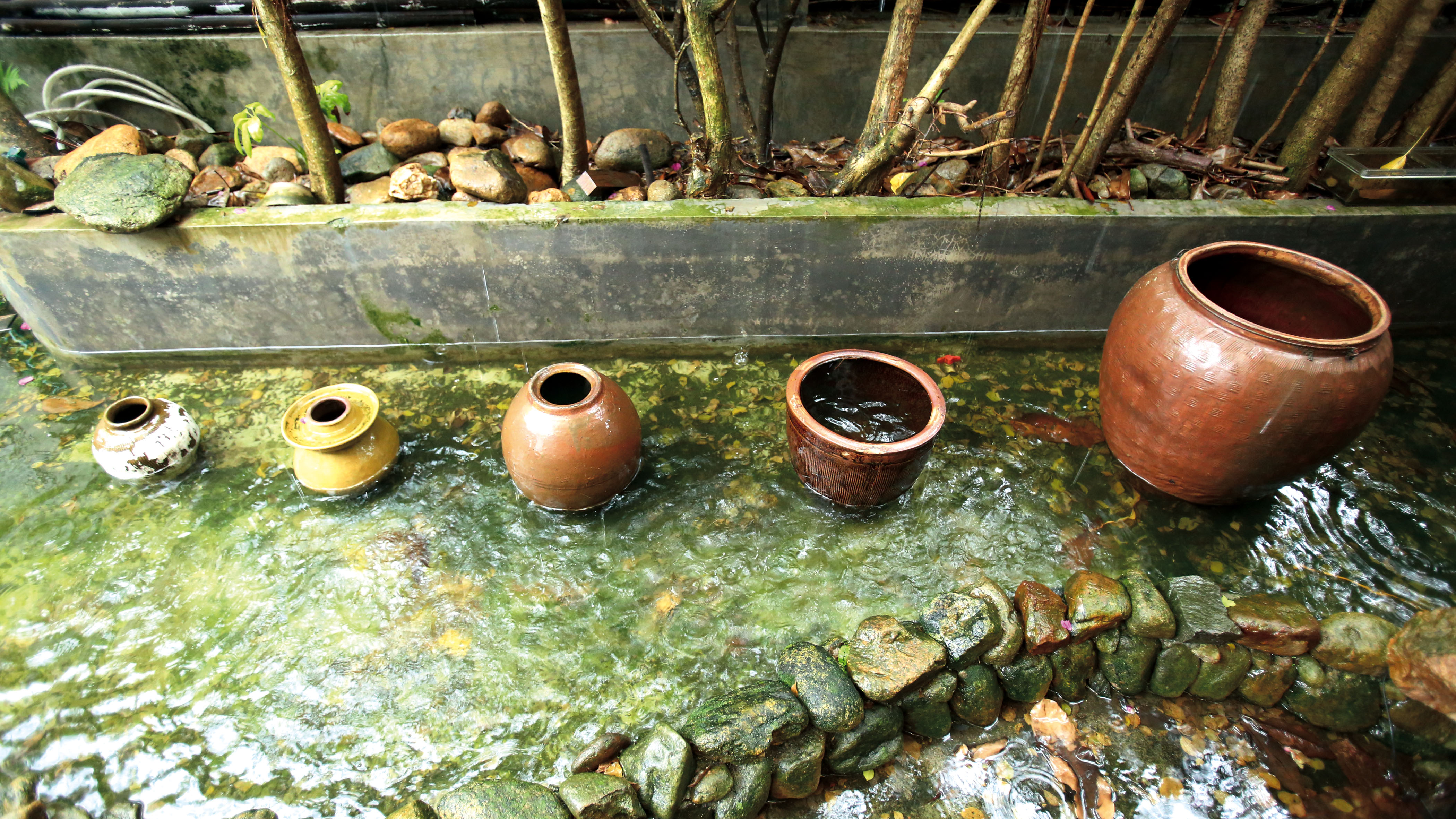 |
|
Five earthware water tanks are placed in the courtyard for frogs to settle in. Shen Piji arranged the tanks in different sizes and varied depth in the water so that the volume and timbre of Hylarana daunchina‘s croaking can be transformed. He kept the everyday life practice of playing the qin to frogs until the animals went into hibernation. |
When playing the qin, Shen Piji founded that it was more “natural” to define the ragged rhythms through dialogues with frogs. In this way, the beats and rhythms produced will be more vivid. The artist thus claims himself as being “apprenticed to frogs.” He thinks that that frequency of the guqin might have resonated with the sounds of Hylarana daunchina, which made him occur like a frog to the species.
Improvisation with Buergeria
Sound | 5'56" | Hengpailing,Shenzhen | 2015
Sound Experiment with Hylarana daunchina, No.1
Video | Hengpailing, Shenzhen | July 11, 2015
In 2015, Shen Piji invited several sound artists to hold three rounds of sound experiment “Faced to Hylarana Daunchina,” using his studio as a concert hall. The first sound experiment took place in the ground floor courtyard of the studio, with the participation of Shi Kesong (Chaozhou zheng/Chaozhou zither), Li Tingqiu (yehu), Qing Miao (stringed instrument & singing), Luo Jun (xiao/vertical bamboo flute), Li Huiming (shakuhachi), Wang Liang (guqin), and Shen Piji (guqin). Based on his memories of and feelings for his home, Shen Piji chose to begin with Chaozhou music, which he had been familiar with since childhood, and invited for this collaboration musicians in the field whose performances could echo with the croaking of frogs. Chaozhou music adopts improvisation as its major performance strategy. For example, without changing the beats and backbone melody of a piece of music, players of Chaozhou Zheng can polish and modify the piece each time it is performed based on their personal understanding and varied feelings at the scene. This also allowed the frogs’ cloaking to engender nuanced influence on the live performance with its variations in the timing of occurrence, frequency, and volume, thus stimulating the performers’ creative energy.
Sound Experiment with Hylarana daunchina, No.2
Video | Hengpailing, Shenzhen | July 18, 2015
The second sound experiment was also carried out in the courtyard of Shen Piji’s studio. Hong Kong sound artist Paul Yip mainly used electronic synthesizers for improvisation. Meanwhile, Japanese New media artist Macoto Cuhara designed a set of infrared sensors, which was then placed on top of the five earthware water tanks. The sensors transmitted the various high-pitched sounds made by frogs to a computer, which transformed the sounds through a device equipped with five frequencies high and low. In the meanwhile, the device also emitted infrared rays that crossed with one another, both transforming the frogs’ croaking into sounds and visualizations. As usual, Shen Piji played the guqin. Together, the works of the three artists formed a new media piece that blended the visual and the audial. Compared with the first sound experiment, the second round witnessed a more intense on-site intervention of the frogs and artists.
Sound Experiment with Hylarana daunchina, No.3 (excerpt)
Video | Hengpailing, Shenzhen | August 29, 2015
Before the third live performance of the sound experiment, Shen Piji made a few recordings of the frogs’ croaking and himself playing the qin. The recordings were then sent to Dickson Dee (Li Chin Sung) and Macoto Cuhara as materials for their creative engagement. The guest artists accordingly made works which they later brought back to the scene of the performance, where they carried out the sound experiment “Faced to Hylarana Daunchina.” During the performance, Dickson Dee used five small speakers to play the five experimental sound pieces he had made. Meanwhile, Macoto Cuhara invented a program to convert the frogs’ croaking into texts in Japanese, Chinese, and English, which together composed a video work. Other participating artists included Lu Zheng, Wang Liang, Li Huiming, and Hui Zi. The sound experiment took place mainly on the third floor of Shen Piji’s studio while speakers were installed in the courtyard, on the stairs, and throughout the house to broadcast the ongoing performance. The artists hope to incorporate their experience of the environment into the performance and enable the audience to be exposed to sounds from different sources from the moment they stepped into the courtyard.
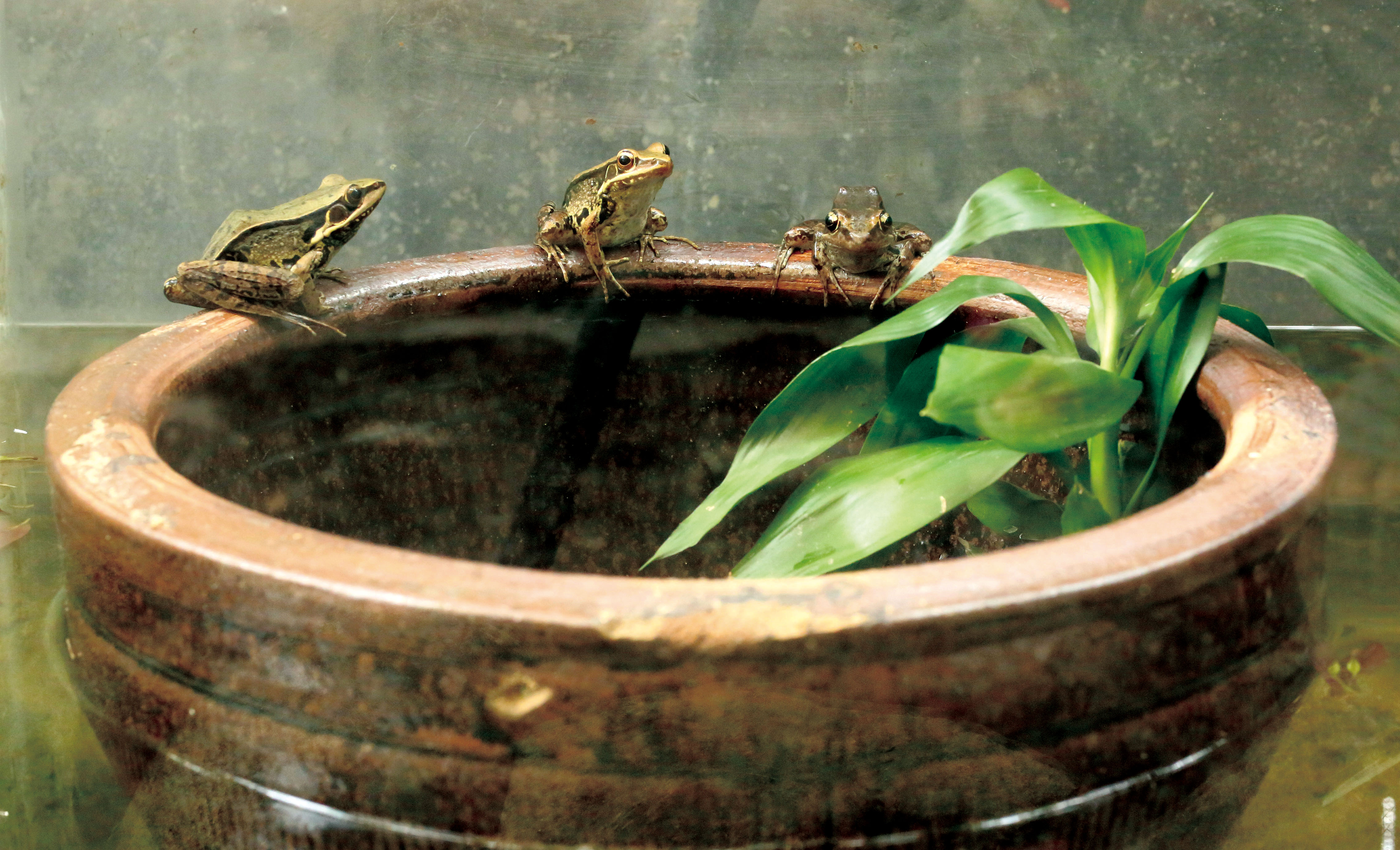 |
|
Hylarana daunchina living in the courtyard of Shen Piji’s studio |
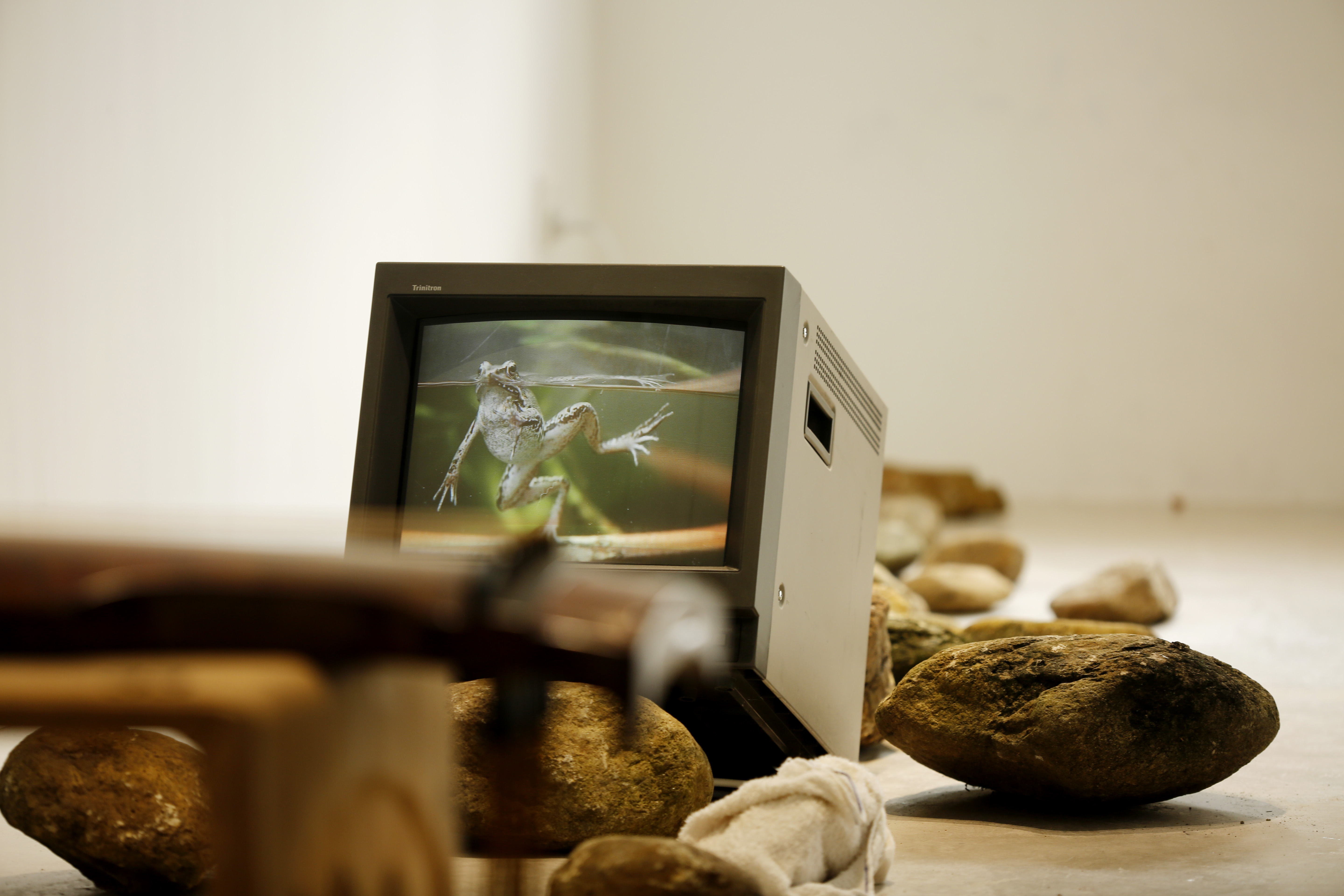 |
|
No matter it is an improvised ensemble with frogs on a usual day or transformations of frogs’ croaking into multi-media forms such as visual and audial works, Shen Piji’s interaction with frogs and his artistic practices always take place in his studio. This means that it is impossible to restage the artist’s everyday experience and the quality of live performance in an exhibition. In 2016, at 33 Space in Shenzhen, the artist tried to interact with the moving image of Hylarana daunchina displayed on the screen of a monitor. |
In the end, whether it is frogs who are being observed by human beings or humans who are been looked at by frogs – this is a question that Shen Piji often pondered in his daily experience of staying with frogs. No matter the artist is in the city center or Wutong Mountain, he must deal with the relationship between himself as an individual and the surroundings. When building relationships with Wutong Mountain, frogs, and the guqin and creating his works, Shen Peiji never intended to construct a mysterious concept of nature that stands alone from human beings. Rather, he chooses to be in a relatively relaxed state in which he can respond to the various factors in life with respect and spontaneity.
Image and video courtesy of the artist. All rights reserved.